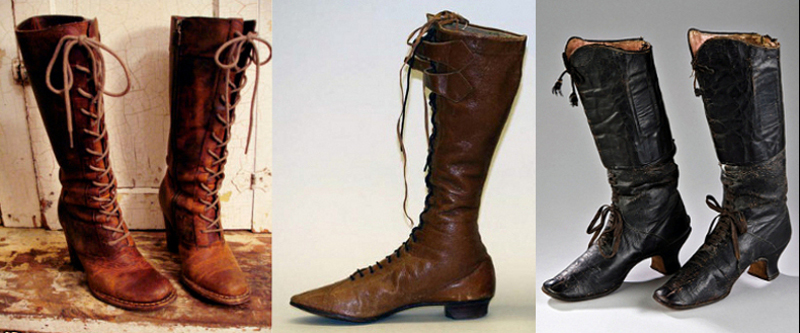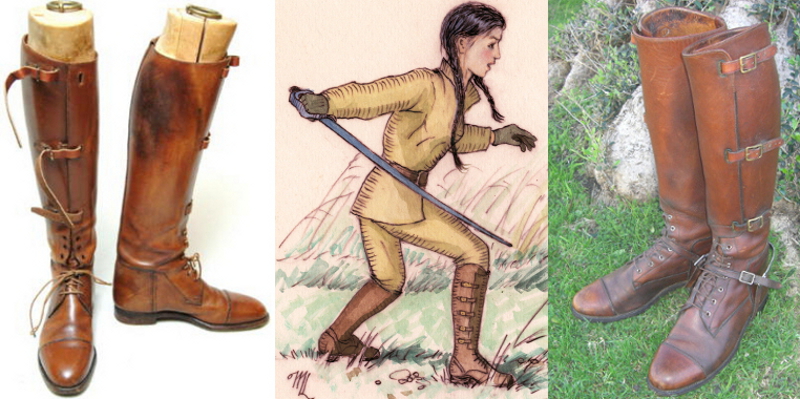When we started looking at drawing images of Kate we referenced fashion plates from the era. However, the women’s feet were generally hidden by the long skirts of the times. Research shows there existed many styles of footwear: plain buttoned ankle brogues, to high-heeled knee-high laced decorated boots, and everything inbetween. We know from her ledger she had pairs made to match different outfits with accompanying gloves and hats, which was the common practise for the wealthy. Any footwear would have had leather soles (rubber heels weren’t used until patented in 1889 by a printer with sore feet) and punched shoelace or buckle holes, as metal eyelets and hooks were not commonly used until the 1890s. Kate spent outrageous amounts on her clothes, her boots would have been the finest money could buy.

Delicate boots crafted with silk and velvet.
Kate wrote of wearing buff field boots, and preferred them for walking or riding. She also made note of them having laces and buckles. I confess, we had to guess as to what they actually looked like. In the Summer of 1852 she listed having a black pair made with five buckles. (We could safely surmise five buckles on each boot.) Searching her ledger a little more carefully we found “5bkls” annotating two other pairs of boots, one set listed as “riding field.” We then looked at riding and field boots of the times. These were the clues we needed to determine what her boots were like.

Sturdy leather ladies boots for the field, riding, and adventure.
Most riding boots of the era were about knee high, and Kate wrote of wearing “dressy tall black riders” under certain circumstances. We felt her field boots must have been a combination of these styles with buckles and a low heel, as she specified they were comfortable for walking, and had to run in them on many occasions. Therefore, our criteria included buff leather, laces, buckles, and modest heel, with black pairs after 1852. (Of interest, listed on display at the Great Exhibition 1851, were ladies riding boots, and hunting boots, with “elastic gores at the bend of the knee, fitting without wrinkles in any position of the leg, and equally adapted for walking or riding,” so multi-purpose boots that came above the knee.)

Boots with laces and buckles, and a painting of Kate battling her way out of a desperate situation.
How common this type of boot was in the 1850s I couldn’t discover, but there are several references to boots with buckles by 1860. Of course these would have been handmade in bespoke pairs by only certain shoemakers. In the 1880s a similar boot had been developed, and being worn by gentlemen, cavalry, and mounted police. By the 1890s a long brown boot with laces and buckles in various forms were mass produced for hunting, riding, policing, and combat. Unfortunately, I couldn’t find an example with five buckles. Kate would have appreciated the ability to adjust the fit on her calves, as she sometimes wore these boots with several layers (silk hose, stockings, socks) and breeches, but other occasions under her dress with just hose and stockings. Whether Kate should get credit for designing this style of boot is up for speculation. Likely it was some innovative Somersetshire shoemaker who deserves the accolades. (Perhaps the man just wanted to use up stockpiled buckles which had gone out of style about twenty years previously.)
We hope you enjoy the articles and short stories presented here, and will join Kate in her adventures for many years to come.
Upon request, you will receive an inscribed copy of Kate Tattersall Adventures in China with every donation of $10 or more plus shipping. Please use the Contact Page to provide your shipping address and we will reply with your total.

Sheri Tortora
Great post! I’d love a pair of boots like that.
Emily Nonu
What a great blog and illuminating posts, I definitely will bookmark your site. Best Regards!
Heather
Tall boots are hot. I’d like to see guys wearing them like they did in the 1800s.
Diane
Equestrian style boots are always in style. I love them.
Lelia
I’d like a pair of good quality lace up leather boots for my adventures!